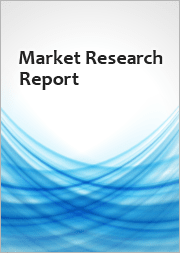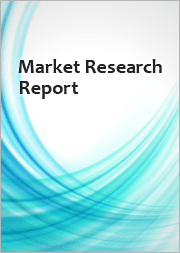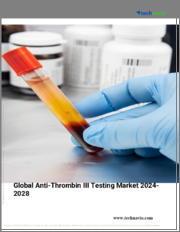
|
시장보고서
상품코드
1668101
안티트롬빈 시장 - 세계 산업 규모, 점유율, 동향, 기회, 예측 : 용도별, 공급원별, 유형별, 지역별, 경쟁별(2020-2030년)Antithrombin Market - Global Industry Size, Share, Trends, Opportunity, and Forecast, Segmented By Usage, By Source, By Type, By Region and Competition, 2020-2030F |
||||||
안티트롬빈 세계 시장 규모는 2024년 7억 8,203만 달러에서 2030년에는 10억 6,623만 달러에 달할 것으로 예상되며, 예측 기간 동안 연평균 5.26%의 CAGR로 성장할 것으로 예상됩니다.
안티트롬빈 시장에는 안티트롬빈 제품을 생산 및 판매하는 제약 및 생명공학 산업의 노력이 포함됩니다. 혈액 내 천연 단백질인 안티트롬빈은 혈액 응고 조절에 중요한 역할을 합니다. 안티트롬빈 수치가 저하되면 심부정맥혈전증(DVT), 폐색전증(PE), 파종성 혈관내응고증후군(DIC) 등 혈전색전증을 유발할 수 있습니다. 따라서 안티트롬빈 제품은 이러한 질환의 예방과 치료 모두에 필수적입니다.
| 시장 개요 | |
|---|---|
| 예측 기간 | 2026-2030년 |
| 시장 규모 : 2024년 | 7억 8,203만 달러 |
| 시장 규모 : 2030년 | 10억 6,623만 달러 |
| CAGR : 2025-2030년 | 5.26% |
| 급성장 부문 | 치료제 |
| 최대 시장 | 아시아태평양 |
시장 촉진요인
혈전성 질환의 유병률 증가
주요 시장 과제
제한된 인식 및 진단
주요 시장 동향
치료 적응증 확대
목차
제1장 개요
제2장 조사 방법
제3장 주요 요약
제4장 고객의 소리
제5장 세계의 안티트롬빈 시장 전망
- 시장 규모 및 예측
- 금액별
- 시장 점유율과 예측
- 용도별(치료, 진단, 연구, 기타)
- 공급원별(인간, 재조합 산양유, 기타)
- 유형별(항응고제, 항혈소판제, 혈전용해제)
- 지역별
- 기업별(2024년)
- 시장 맵
제6장 북미의 안티트롬빈 시장 전망
- 시장 규모 및 예측
- 시장 점유율과 예측
- 북미 : 국가별 분석
- 캐나다
- 멕시코
제7장 유럽의 안티트롬빈 시장 전망
- 시장 규모 및 예측
- 시장 점유율과 예측
- 유럽 : 국가별 분석
- 영국
- 이탈리아
- 프랑스
- 스페인
제8장 아시아태평양의 안티트롬빈 시장 전망
- 시장 규모 및 예측
- 시장 점유율과 예측
- 아시아태평양 : 국가별 분석
- 인도
- 일본
- 한국
- 호주
제9장 남미의 안티트롬빈 시장 전망
- 시장 규모 및 예측
- 시장 점유율과 예측
- 남미 : 국가별 분석
- 아르헨티나
- 콜롬비아
제10장 중동 및 아프리카의 안티트롬빈 시장 전망
- 시장 규모 및 예측
- 시장 점유율과 예측
- 중동 및 아프리카 : 국가별 분석
- 사우디아라비아
- 아랍에미리트
제11장 시장 역학
- 성장 촉진요인
- 과제
제12장 시장 동향과 발전
- 인수합병(있는 경우)
- 제품 발매(있는 경우)
- 최근 동향
제13장 Porter's Five Forces 분석
- 업계내 경쟁
- 신규 참여의 가능성
- 공급업체의 능력
- 고객의 능력
- 대체품의 위협
제14장 경쟁 구도
- Grifols, S.A.
- Takeda Pharmaceutical Company Limited
- Octapharma Brasil Ltda.
- LFB USA, Inc.
- Endpoint Health, Inc.
- Siemens Healthineers AG
- Thermo Fisher Scientific Inc
- BioCare, Inc.
- F. Hoffmann-La Roche Ltd
- Kedrion S.p.A
제15장 전략적 제안
제16장 조사 회사 소개 및 면책사항
ksm 25.03.19The global antithrombin market was valued at USD 782.03 million in 2024 and is projected to reach USD 1,066.23 million by 2030, growing at a CAGR of 5.26% during the forecast period. The antithrombin market encompasses the pharmaceutical and biotechnology industries' efforts to produce and distribute antithrombin products. Antithrombin, a naturally occurring protein in the blood, plays a crucial role in regulating blood clotting. When antithrombin levels are dysfunctional, it can lead to thromboembolic disorders such as deep vein thrombosis (DVT), pulmonary embolism (PE), and disseminated intravascular coagulation (DIC). Antithrombin products are therefore critical for both the prevention and treatment of these conditions.
| Market Overview | |
|---|---|
| Forecast Period | 2026-2030 |
| Market Size 2024 | USD 782.03 Million |
| Market Size 2030 | USD 1066.23 Million |
| CAGR 2025-2030 | 5.26% |
| Fastest Growing Segment | Therapeutics |
| Largest Market | Asia-Pacific |
Key Market Drivers
Rising Prevalence of Thrombotic Disorders
Thrombotic disorders, marked by the formation of blood clots within the circulatory system, are a significant global health threat. As the incidence of these conditions rises, so does the demand for effective treatments. Antithrombin products are becoming essential in the management and prevention of thrombotic events.
Thrombotic disorders include DVT, PE, stroke, and DIC, which can lead to severe complications, such as organ damage and death. According to the World Health Organization (WHO), thrombosis is a major contributor to global morbidity and mortality. In the U.S., the Centers for Disease Control and Prevention reports that venous thromboembolism (VTE) affects up to 900,000 people annually, with 60,000 to 100,000 deaths attributed to the condition each year. Additionally, many individuals experience long-term complications. Risk factors for thrombotic events include advanced age, sedentary lifestyles, obesity, diabetes, cancer, cardiovascular disease, and genetic predisposition. Major surgeries, particularly orthopedic, cardiovascular, and gynecological procedures, also increase the risk of clot formation. As a result, antithrombin products are often used prophylactically in these high-risk scenarios.
Antithrombin, a natural protein in the bloodstream, regulates the clotting process by inhibiting key clotting factors, including thrombin and factor Xa. When antithrombin levels are deficient or impaired, the likelihood of clot formation increases. Consequently, the growing prevalence of thrombotic disorders is driving increased demand for antithrombin products, both for prevention and treatment. The rise in surgical procedures and the need for antithrombin therapy for patients experiencing thrombotic events further contribute to market growth. The increasing need for advanced antithrombin therapies, such as recombinant products, is also fueling research and development in the market.
Key Market Challenges
Limited Awareness and Diagnosis
One of the significant challenges facing the antithrombin market is the lack of awareness about thrombotic disorders such as DVT and PE. These conditions often present with subtle or non-specific symptoms, and many individuals are unaware of their risk factors. Common symptoms, such as leg pain, swelling, or difficulty breathing, are often overlooked or misattributed to less severe conditions, delaying diagnosis and treatment. This lack of awareness hinders timely medical intervention, reducing the demand for antithrombin therapies.
Without early detection, thrombotic disorders can lead to severe health consequences, including organ damage, stroke, or death. Therefore, raising awareness of thrombotic disorders, their symptoms, and the importance of early diagnosis is crucial for improving patient outcomes and expanding the market for antithrombin products.
Key Market Trends
Expanding Therapeutic Indications
Historically, antithrombin therapies have been primarily associated with the treatment of thrombotic disorders. However, ongoing research and clinical trials are expanding the potential therapeutic applications of these treatments. For example, antithrombin products are being explored for their role in sepsis, a severe systemic response to infection where blood clotting contributes to organ failure. By targeting the coagulation pathway, antithrombin therapies may help manage sepsis-induced coagulopathy, improving patient outcomes.
In February 2022, Grifols partnered with Endpoint Health, Inc. to develop a therapy for sepsis using Antithrombin III (AT-III). This collaboration aims to leverage Grifols' expertise in plasma-protein therapies, with the company serving as the exclusive provider of AT-III.
Antithrombin products are also being investigated for their potential benefits in liver diseases such as cirrhosis and acute liver failure, where blood clotting factors play a key role in disease progression. Additionally, these therapies are being studied as adjuncts to cancer treatments, as tumors can cause coagulation system alterations, increasing the risk of thrombotic events in cancer patients.
The expansion of therapeutic indications presents new opportunities for the antithrombin market. As antithrombin therapies gain recognition in treating a broader range of conditions, such as sepsis, liver diseases, and cancer, the demand for these products is expected to increase, opening new market avenues and enhancing patient outcomes in complex, life-threatening diseases.
Key Market Players
- Grifols, S.A.
- Takeda Pharmaceutical Company Limited
- Octapharma Brasil Ltda.
- LFB USA, Inc.
- Endpoint Health, Inc.
- Siemens Healthineers AG
- Thermo Fisher Scientific Inc
- BioCare, Inc.
- F. Hoffmann-La Roche Ltd
- Kedrion S.p.A
Report Scope:
In this report, the Global Antithrombin Market has been segmented into the following categories, in addition to the industry trends which have also been detailed below:
Antithrombin Market, By Usage:
- Therapeutics
- Diagnostics
- Research
- Others
Antithrombin Market, By Source:
- Human
- Recombinant Goat Milk
- Others
Antithrombin Market, By Type:
- Anticoagulant
- Antiplatelet
- Thrombolytic Drugs
Antithrombin Market, By Region:
- North America
- United States
- Canada
- Mexico
- Europe
- Germany
- United Kingdom
- France
- Italy
- Spain
- Asia-Pacific
- China
- Japan
- India
- Australia
- South Korea
- South America
- Brazil
- Argentina
- Colombia
- Middle East & Africa
- South Africa
- Saudi Arabia
Competitive Landscape
Company Profiles: Detailed analysis of the major companies present in the Global Antithrombin Market.
Available Customizations:
Global Antithrombin market report with the given market data, TechSci Research offers customizations according to a company's specific needs. The following customization options are available for the report:
Company Information
- Detailed analysis and profiling of additional market players (up to five).
Table of Contents
1. Product Overview
- 1.1. Market Definition
- 1.2. Scope of the Market
- 1.2.1. Markets Covered
- 1.2.2. Years Considered for Study
- 1.2.3. Key Market Segmentations
2. Research Methodology
- 2.1. Objective of the Study
- 2.2. Baseline Methodology
- 2.3. Key Industry Partners
- 2.4. Major Association and Secondary Sources
- 2.5. Forecasting Methodology
- 2.6. Data Triangulation & Validations
- 2.7. Assumptions and Limitations
3. Executive Summary
- 3.1. Overview of the Market
- 3.2. Overview of Key Market Segmentations
- 3.3. Overview of Key Market Players
- 3.4. Overview of Key Regions/Countries
- 3.5. Overview of Market Drivers, Challenges, Trends
4. Voice of Customer
5. Global Antithrombin Market Outlook
- 5.1. Market Size & Forecast
- 5.1.1. By Value
- 5.2. Market Share & Forecast
- 5.2.1. By Usage (Therapeutics, Diagnostics, Research, Others)
- 5.2.2. By Source (Human, Recombinant Goat Milk, Others)
- 5.2.3. By Type (Anticoagulant, Antiplatelet, Thrombolytic Drugs)
- 5.2.4. By Region
- 5.2.5. By Company (2024)
- 5.3. Market Map
6. North America Antithrombin Market Outlook
- 6.1. Market Size & Forecast
- 6.1.1. By Value
- 6.2. Market Share & Forecast
- 6.2.1. By Usage
- 6.2.2. By Source
- 6.2.3. By Type
- 6.2.4. By Country
- 6.3. North America: Country Analysis
- 6.3.1. United States Antithrombin Market Outlook
- 6.3.1.1. Market Size & Forecast
- 6.3.1.1.1. By Value
- 6.3.1.2. Market Share & Forecast
- 6.3.1.2.1. By Usage
- 6.3.1.2.2. By Source
- 6.3.1.2.3. By Type
- 6.3.1.1. Market Size & Forecast
- 6.3.2. Canada Antithrombin Market Outlook
- 6.3.2.1. Market Size & Forecast
- 6.3.2.1.1. By Value
- 6.3.2.2. Market Share & Forecast
- 6.3.2.2.1. By Usage
- 6.3.2.2.2. By Source
- 6.3.2.2.3. By Type
- 6.3.2.1. Market Size & Forecast
- 6.3.3. Mexico Antithrombin Market Outlook
- 6.3.3.1. Market Size & Forecast
- 6.3.3.1.1. By Value
- 6.3.3.2. Market Share & Forecast
- 6.3.3.2.1. By Usage
- 6.3.3.2.2. By Source
- 6.3.3.2.3. By Type
- 6.3.3.1. Market Size & Forecast
- 6.3.1. United States Antithrombin Market Outlook
7. Europe Antithrombin Market Outlook
- 7.1. Market Size & Forecast
- 7.1.1. By Value
- 7.2. Market Share & Forecast
- 7.2.1. By Usage
- 7.2.2. By Source
- 7.2.3. By Type
- 7.2.4. By Country
- 7.3. Europe: Country Analysis
- 7.3.1. Germany Antithrombin Market Outlook
- 7.3.1.1. Market Size & Forecast
- 7.3.1.1.1. By Value
- 7.3.1.2. Market Share & Forecast
- 7.3.1.2.1. By Usage
- 7.3.1.2.2. By Source
- 7.3.1.2.3. By Type
- 7.3.1.1. Market Size & Forecast
- 7.3.2. United Kingdom Antithrombin Market Outlook
- 7.3.2.1. Market Size & Forecast
- 7.3.2.1.1. By Value
- 7.3.2.2. Market Share & Forecast
- 7.3.2.2.1. By Usage
- 7.3.2.2.2. By Source
- 7.3.2.2.3. By Type
- 7.3.2.1. Market Size & Forecast
- 7.3.3. Italy Antithrombin Market Outlook
- 7.3.3.1. Market Size & Forecast
- 7.3.3.1.1. By Value
- 7.3.3.2. Market Share & Forecast
- 7.3.3.2.1. By Usage
- 7.3.3.2.2. By Source
- 7.3.3.2.3. By Type
- 7.3.3.1. Market Size & Forecast
- 7.3.4. France Antithrombin Market Outlook
- 7.3.4.1. Market Size & Forecast
- 7.3.4.1.1. By Value
- 7.3.4.2. Market Share & Forecast
- 7.3.4.2.1. By Usage
- 7.3.4.2.2. By Source
- 7.3.4.2.3. By Type
- 7.3.4.1. Market Size & Forecast
- 7.3.5. Spain Antithrombin Market Outlook
- 7.3.5.1. Market Size & Forecast
- 7.3.5.1.1. By Value
- 7.3.5.2. Market Share & Forecast
- 7.3.5.2.1. By Usage
- 7.3.5.2.2. By Source
- 7.3.5.2.3. By Type
- 7.3.5.1. Market Size & Forecast
- 7.3.1. Germany Antithrombin Market Outlook
8. Asia-Pacific Antithrombin Market Outlook
- 8.1. Market Size & Forecast
- 8.1.1. By Value
- 8.2. Market Share & Forecast
- 8.2.1. By Usage
- 8.2.2. By Source
- 8.2.3. By Type
- 8.2.4. By Country
- 8.3. Asia-Pacific: Country Analysis
- 8.3.1. China Antithrombin Market Outlook
- 8.3.1.1. Market Size & Forecast
- 8.3.1.1.1. By Value
- 8.3.1.2. Market Share & Forecast
- 8.3.1.2.1. By Usage
- 8.3.1.2.2. By Source
- 8.3.1.2.3. By Type
- 8.3.1.1. Market Size & Forecast
- 8.3.2. India Antithrombin Market Outlook
- 8.3.2.1. Market Size & Forecast
- 8.3.2.1.1. By Value
- 8.3.2.2. Market Share & Forecast
- 8.3.2.2.1. By Usage
- 8.3.2.2.2. By Source
- 8.3.2.2.3. By Type
- 8.3.2.1. Market Size & Forecast
- 8.3.3. Japan Antithrombin Market Outlook
- 8.3.3.1. Market Size & Forecast
- 8.3.3.1.1. By Value
- 8.3.3.2. Market Share & Forecast
- 8.3.3.2.1. By Usage
- 8.3.3.2.2. By Source
- 8.3.3.2.3. By Type
- 8.3.3.1. Market Size & Forecast
- 8.3.4. South Korea Antithrombin Market Outlook
- 8.3.4.1. Market Size & Forecast
- 8.3.4.1.1. By Value
- 8.3.4.2. Market Share & Forecast
- 8.3.4.2.1. By Usage
- 8.3.4.2.2. By Source
- 8.3.4.2.3. By Type
- 8.3.4.1. Market Size & Forecast
- 8.3.5. Australia Antithrombin Market Outlook
- 8.3.5.1. Market Size & Forecast
- 8.3.5.1.1. By Value
- 8.3.5.2. Market Share & Forecast
- 8.3.5.2.1. By Usage
- 8.3.5.2.2. By Source
- 8.3.5.2.3. By Type
- 8.3.5.1. Market Size & Forecast
- 8.3.1. China Antithrombin Market Outlook
9. South America Antithrombin Market Outlook
- 9.1. Market Size & Forecast
- 9.1.1. By Value
- 9.2. Market Share & Forecast
- 9.2.1. By Usage
- 9.2.2. By Source
- 9.2.3. By Type
- 9.2.4. By Country
- 9.3. South America: Country Analysis
- 9.3.1. Brazil Antithrombin Market Outlook
- 9.3.1.1. Market Size & Forecast
- 9.3.1.1.1. By Value
- 9.3.1.2. Market Share & Forecast
- 9.3.1.2.1. By Usage
- 9.3.1.2.2. By Source
- 9.3.1.2.3. By Type
- 9.3.1.1. Market Size & Forecast
- 9.3.2. Argentina Antithrombin Market Outlook
- 9.3.2.1. Market Size & Forecast
- 9.3.2.1.1. By Value
- 9.3.2.2. Market Share & Forecast
- 9.3.2.2.1. By Usage
- 9.3.2.2.2. By Source
- 9.3.2.2.3. By Type
- 9.3.2.1. Market Size & Forecast
- 9.3.3. Colombia Antithrombin Market Outlook
- 9.3.3.1. Market Size & Forecast
- 9.3.3.1.1. By Value
- 9.3.3.2. Market Share & Forecast
- 9.3.3.2.1. By Usage
- 9.3.3.2.2. By Source
- 9.3.3.2.3. By Type
- 9.3.3.1. Market Size & Forecast
- 9.3.1. Brazil Antithrombin Market Outlook
10. Middle East and Africa Antithrombin Market Outlook
- 10.1. Market Size & Forecast
- 10.1.1. By Value
- 10.2. Market Share & Forecast
- 10.2.1. By Usage
- 10.2.2. By Source
- 10.2.3. By Type
- 10.2.4. By Country
- 10.3. MEA: Country Analysis
- 10.3.1. South Africa Antithrombin Market Outlook
- 10.3.1.1. Market Size & Forecast
- 10.3.1.1.1. By Value
- 10.3.1.2. Market Share & Forecast
- 10.3.1.2.1. By Usage
- 10.3.1.2.2. By Source
- 10.3.1.2.3. By Type
- 10.3.1.1. Market Size & Forecast
- 10.3.2. Saudi Arabia Antithrombin Market Outlook
- 10.3.2.1. Market Size & Forecast
- 10.3.2.1.1. By Value
- 10.3.2.2. Market Share & Forecast
- 10.3.2.2.1. By Usage
- 10.3.2.2.2. By Source
- 10.3.2.2.3. By Type
- 10.3.2.1. Market Size & Forecast
- 10.3.3. UAE Antithrombin Market Outlook
- 10.3.3.1. Market Size & Forecast
- 10.3.3.1.1. By Value
- 10.3.3.2. Market Share & Forecast
- 10.3.3.2.1. By Usage
- 10.3.3.2.2. By Source
- 10.3.3.2.3. By Type
- 10.3.3.1. Market Size & Forecast
- 10.3.1. South Africa Antithrombin Market Outlook
11. Market Dynamics
- 11.1. Drivers
- 11.2. Challenges
12. Market Trends & Developments
- 12.1. Merger & Acquisition (If Any)
- 12.2. Product Launches (If Any)
- 12.3. Recent Developments
13. Porter's Five Forces Analysis
- 13.1. Competition in the Industry
- 13.2. Potential of New Entrants
- 13.3. Power of Suppliers
- 13.4. Power of Customers
- 13.5. Threat of Substitute Products
14. Competitive Landscape
- 14.1. Grifols, S.A.
- 14.1.1. Business Overview
- 14.1.2. Company Snapshot
- 14.1.3. Products & Services
- 14.1.4. Financials (As Reported)
- 14.1.5. Recent Developments
- 14.1.6. Key Personnel Details
- 14.1.7. SWOT Analysis
- 14.2. Takeda Pharmaceutical Company Limited
- 14.3. Octapharma Brasil Ltda.
- 14.4. LFB USA, Inc.
- 14.5. Endpoint Health, Inc.
- 14.6. Siemens Healthineers AG
- 14.7. Thermo Fisher Scientific Inc
- 14.8. BioCare, Inc.
- 14.9. F. Hoffmann-La Roche Ltd
- 14.10. Kedrion S.p.A
15. Strategic Recommendations
16. About Us & Disclaimer
(주말 및 공휴일 제외)














